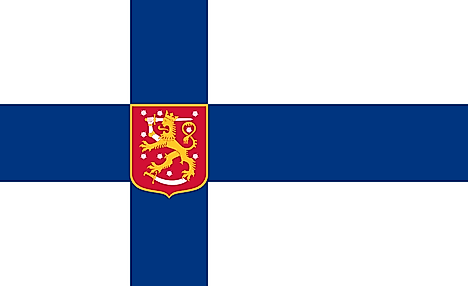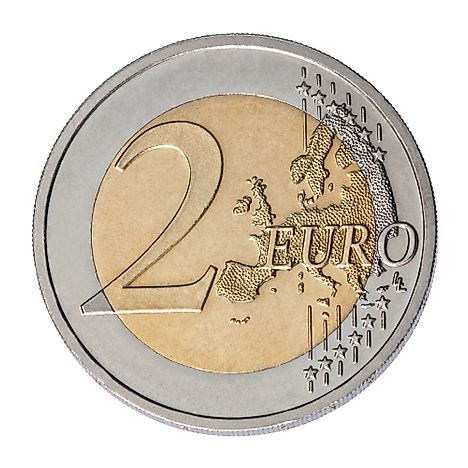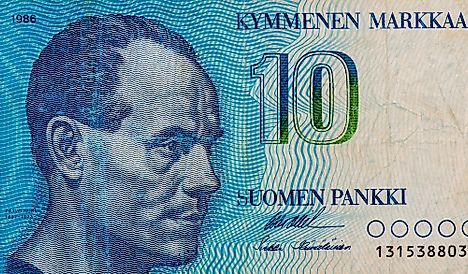Flags, Symbols & Currency of Finland
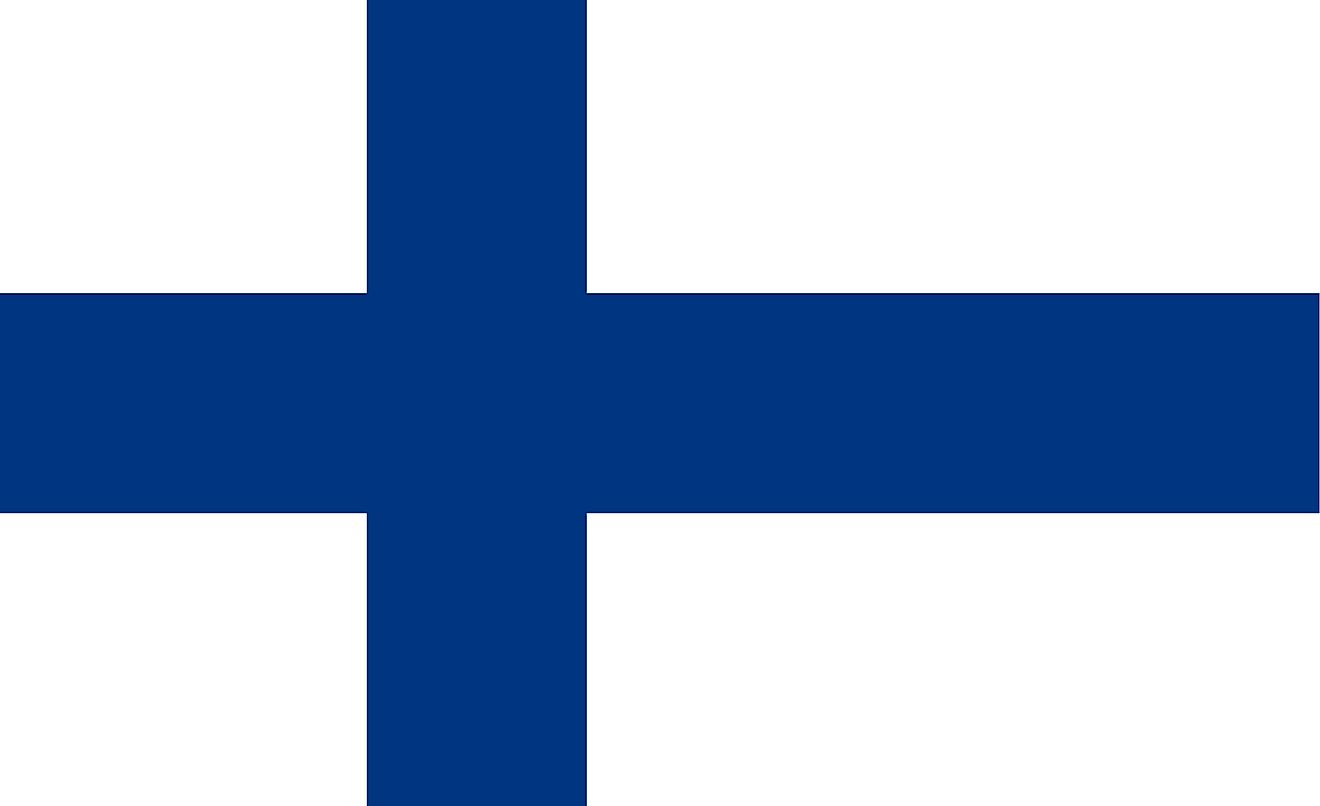
The National Flag of Finland was officially adopted on May 29, 1918. It is also referred to as Siniristilippu (“Blue Cross Flag”)
The National Flag of Finland features a white background with a blue cross that extends to the edges of the flag. The vertical part of the blue Nordic cross is shifted to the hoist side in the style of the Dannebrog (Danish flag). The blue color represents the blue skies and the thousands of lakes which are scattered across the country. The white color symbolizes the snow that covers the land during winter. The Scandinavian cross represents the religion of Christianity. The flag has a width-to-length proportion ratio of 11:18.
History of the Flag of Finland
The modern blue-crossed flag was first used in 1861 by a yacht club in Helsinki called Nylandska Jaktklubben. From 1899-1917, Finland was occupied by Russia. During this time, a Russian flag was added to the Finnish flag. This flag was referred as the “slave’s flag” and was refused to be used by most of the citizens. After the independence of Finland in 1917, a competition was organized for designing of the flag. The Finnish “blue-crossed flag” was officially adopted on May 29, 1918.
Symbols of Finland
The National Coat of Arms of Finland
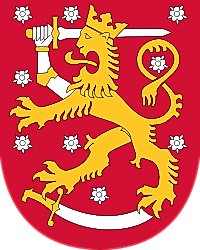
The original design of the coat of arms first appeared in the 1580's on the monument of Gustav Vasa in Uppsala Cathedral. It was later adopted by the newly independent Finland as its national arms in 1917. It features a crowned lion placed on a red background. The lion is found holding a raised sword in an armoured hand, that has replaced the animal's right front leg. The lion is also trampling a sabre with its hind legs. The lion, the crown, the hilts and the joints of the armour are in gold, while the blades of the weapons, and the armour are in silver. Nine silver rosettes are found scattered on the background.
National Motto
"Vart Land" "Our Land"
National Anthem
- Anthem Title: "Maamee" (Finnish) or Vårt land (Swedish)
- Composer: Fredrik Pacius
- Lyricist: Johan Ludvig Runeberg
- Date of First Performance: May 13th, 1848
- Date of Adoption: Unspecified
"Maamee" ("Our Land") is the national anthem of Finland. The music of the anthem have been composed by Fredrik Pacius. The lyrics of the anthem have been authored by Johan Ludvig Runeberg. The anthem has never been officially legislated as the Finnish anthem. The anthem has full 11 -verses; only the first and last verses (marked in bold) are usually sung.
Vårt land (Swedish)
1.
Vårt land, vårt land, vårt fosterland,
Ljud högt, o dyra ord!
? Ej lyfts en höjd mot himlens rand,
Ej sänks en dal, ej sköljs en strand,
Mer älskad än vår bygd i nord,
Än våra fäders jord. ?
2.
Vårt land är fattigt, skall så bli
För den, som guld begär.
En främling far oss stolt förbi:
Men detta landet älska vi,
För oss med moar, fjäll och skär
Ett guldland dock det är.
3.
Vi älska våra strömmars brus
Och våra bäckars språng.
Den mörka skogens dystra sus,
Vår stjärnenatt, vårt sommarljus.
Allt, allt, vad här som syn, som sång
Vårt hjärta rört en gång.
4.
Här striddes våra fäders strid
Med tanke, svärd och plog.
Här, här, i klar som mulen tid.
Med lycka hård, med lycka blid.
Det finska folkets hjärta slog.
Här bars vad det fördrog.
5.
Vem täljde väl de striders tal.
Som detta folk bestod.
Då kriget röt från dal till dal.
Då frosten kom med hungers kval.
Vem mätte allt dess spillda blod
Och allt dess tålamod?
6.
Och det var här det blodet flöt,
Ja, här för oss det var,
Och det var här sin fröjd det njöt,
Och det var här sin suck det göt.
Det folk som våra bördor bar
Långt före våra dar.
7.
Här är oss ljuvt, här är oss gott,
Här är oss allt beskärt;
Hur ödet kastar än vår lott.
Ett land, ett fosterland vi fått,
Vad finns på jorden mera värt
Att hållas dyrt och kärt?
8.
Och här och här är detta land.
Vårt öga ser det här,
Vi kunna sträcka ut vår hand
Och visa glatt på sjö och strand
Och säga: se det landet där.
Vårt fosterland det är.
9.
Och fördes vi att bo i glans
Bland guldmoln i det blå,
Och blev vårt liv en stjärnedans.
Där tår ej göts, där suck ej fanns.
Till detta arma land ändå
Vår längtan skulle stå.
10.
O land, du tusen sjöars land,
Där sång och trohet byggt,
Där livets hav oss gett en strand,
Vår forntids land, vår framtids land.
Var för din fattigdom ej skyggt.
Var fritt, var glatt, var tryggt.
11.
Din blomning, sluten än i knopp,
Skall mogna ur sitt tvång;
Se, ur vår kärlek skall gå opp
Ditt ljus, din glans, din fröjd, ditt hopp.
Och högre klinga skall en gång
Vår fosterländska sång.
"Our Land"
1.
Our land, our land, our Fatherland!
Ring out, dear word, oh sound!
? No rising hill, or mountain grand,
No sloping dale, no northern strand,
There is, more loved, to be found,
Than this — our fathers’ ground. ?
2.
Our land is poor, and so shall be
To him who gold will crave.
The strangers proudly pass, but we
Shall ever love this land, we see,
In moor, and fell, and isle and wave,
A golden land, so brave.
3.
We love our rippling brooks, so bright,
Our gushing streams, so strong,
The whisper of dark woods, at night,
Our starry skies, our summer light,
All, all that we, in sight and song,
Have felt and lived among.
4.
Here fought our fathers, without fear,
With sword, and plough, and thought.
And here, in clouded times, and clear,
With fortune in their front or rear,
Their Finnish hearts have beat, and wrought
And borne what bear they ought.
5.
Who tells, of all the fights, the tale,
In which this folk withstood,
When war did rage from dale to dale,
When frost set in, with hunger’s wail?
Who measured all their pouring blood,
And all their patience good?
6.
And it was here their blood was shed,
For us, here, on this shore;
And it was here their joys were bred,
Here, that their sighs were heaved and fled,
That people’s who our burdens bore
Before us, long before.
7.
Here it is sweet and good, we wot,
All, too, is giv’n us here;
However fate may cast our lot,
A land, a fatherland, we’ve got.
Will there a thing on earth appear
More worthy, to hold dear?
8.
And here’s, and here’s this fatherland,
Here every eye it sees;
And we can stretch a pointing hand,
To show, with joy, its sea and strand,
And say, “Behold this country, this,
Our Fatherland it is.”
9.
And if we once were made to rise
To gold clouds, from below,
And if we moved in starry skies,
Where no one weeps, where no one sighs,
To this poor lonely country, though,
Our longing hearts would go.
10.
Oh land, the thousand lakes’ own land,
Of faith, and lay, and glee,
Where life’s main sea gave us a strand,
Our fore-time’s land, our future’s land,
Shy of thy poorness, never be,
Be calm, be glad, be free!
11.
Thy blossom, hidden now from sight,
Shall burst its bud ere long.
Lo! from our love, shall rise aright,
Thy sun, thy hope, thy joy, thy light,
And higher, once, more full and strong,
Shall ring Our Country’s song.
The Currency of Finland is the Euro
The current official currency in Finland is the euro.
Coins
The Finnish euro coins have three designs, the Heikki Haivaoja design adopted by the one cent and 50 cent coins, the Ramao Heino designed two euro coin, and the Perti Makinen designed 1 euro coin. The Goldenberry of northern Finland is printed on a two euro coin.
Bank Notes
The first Finnish markka notes were designed and issued in 1980 and 1986 respectively. A 20 markka note had an image of Vainio Lina fraudulently; the bank had not received the copyrights from the owners. The fraud was discovered later after several million notes were in circulation. The second series of markka notes came into use in 1955 and were revised in 1965. Unlike euro coins, euro notes have the same design across the euro zone. Its denominations are in 5, 10, 20, 50, 100, 200, and 500. They are made of pure cotton fiber to increase its durability and to give the note a distinct texture.
Historical Currencies of Finland
The National Bank of Finland introduced the Finnish markka in 1860 which brought about the replacement of the first Russian ruble at a rate of one ruble per four Finnish markka. In 1865, the Finnish markka was tied to silver and separated from the Russian ruble. The Latin Monetary Union Gold Standard valuation system was adopted by the Finnish government in 1878-1915 and during World War I the markka fluctuated unevenly. After the country gained its independence in 1917, the gold standard system was reinstated in the nation. After undergoing a transition period from 1999 to 2002, the euro became the official legal tender in 2002. The double legal tender system of the markka and the euro ended on February 28, 2002.
